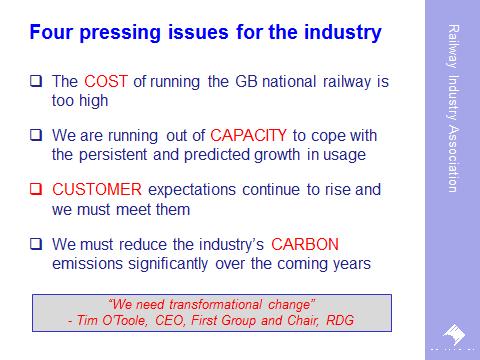The Railway Technical Strategy by Francis How, Technical Director of the Railway Industry Association.
The meeting was held in the East Midlands Trains Academy in Derby and was attended by fourteen members. An introduction was given by Mike Christelow, Branch Committee member in which he outlined how the Rail Technical Strategy fits with the IRO Midlands theme this year of developing a sustainable and future-proof railway for CP5 and beyond.
This theme was expanded to great effect by the presenter Francis How. Francis began by setting the context of the Railway Industry Association (RIA), saying that the association has 170 members from “across the board” including manufacturers like Bombardier, signalling companies, contractors and also includes Network Rail’s consultancy arm. The RIA works with a number of other bodies including UKTI, the export side of the government’s Department for Business, Innovation and Skills.
Francis then moved to the main topic of his presentation, the Rail Technical Strategy itself. He continued with an excellent examination of the strategy which expanded on “the four C’s” – Costs, Capacity, Customers and Carbon. Examples were given in each section and were liberally illustrated with graphs, photos and diagrams. These four main challenges can be summarised as

Cost and Carbon are inextricably linked. In simple terms, the energy is costing more and the railway is consuming more of it. Reducing the carbon emissions of the industry against this background will be challenging.
Capacity on the Railway is a major issue with much increased (and increasing) demand:
• Passenger journeys up from 13 billion in 1995 to 21 billion in 2012
• Freight journeys up from 761 million net tonne kilometres in 1995 to 1.4 million in 2012.
The overall rail strategy which was produced in 2012 was preceded by one in 2007 but technology and innovation are moving at a pace. The new strategy applies to the rail network in the UK but does not include LUL or light railway. It is a twenty five year view and is supported by some funding which was approved in CP5.
The aims of the strategy are concentrated on vision, being technology-centric, and, people. There are six main areas of inclusion which can be seen at www.futurerailway.org.
Examples of areas of study were given, e.g. the mass of trains and how it might be improved with lighter shells, cab ends and use of composite materials in construction. Optimal driving and the growing significance of DAS (Driver Advisory Systems) has also come under scrutiny and any side-issues are also studied to enable overall improvement.
Francis also illustrated how the technical strategy links to customers and their experience of the railway. Ultimately, he said, customers want to buy a journey i.e. car park ticket, train ticket, bus ticket, etc., rather than a series of individual transport mode events. Much of this is now available electronically but the railway has some way to go to embrace this opportunity. It is hoped that Traffic Management will be eventually be “closed loop” thus increasing efficiency.
This was a fascinating, revealing and very comprehensive presentation, delivered with great aplomb. It solicited some considerable discussion and questions from the audience who clearly thoroughly enjoyed the evening.
Our thanks go to Francis How for his excellent presentation, and to Tony James of East Midlands Trains who hosted the event.
Click here to download a copy of the presentation.

Contact us